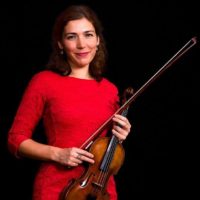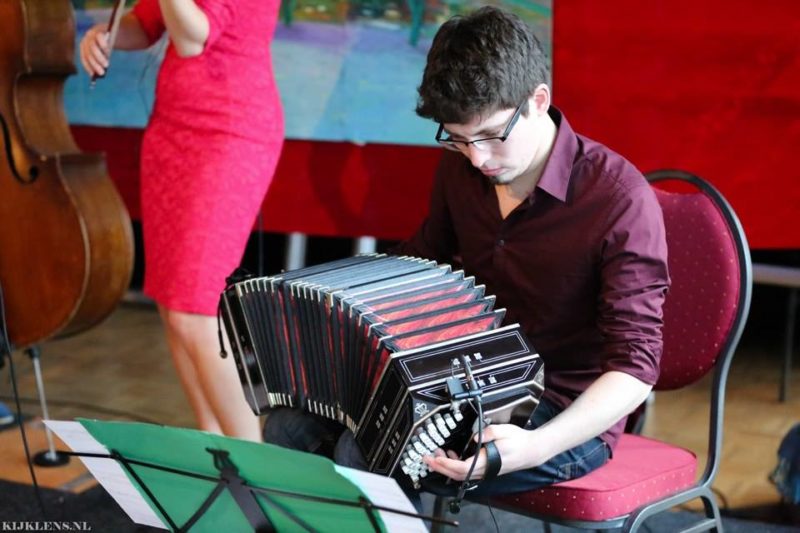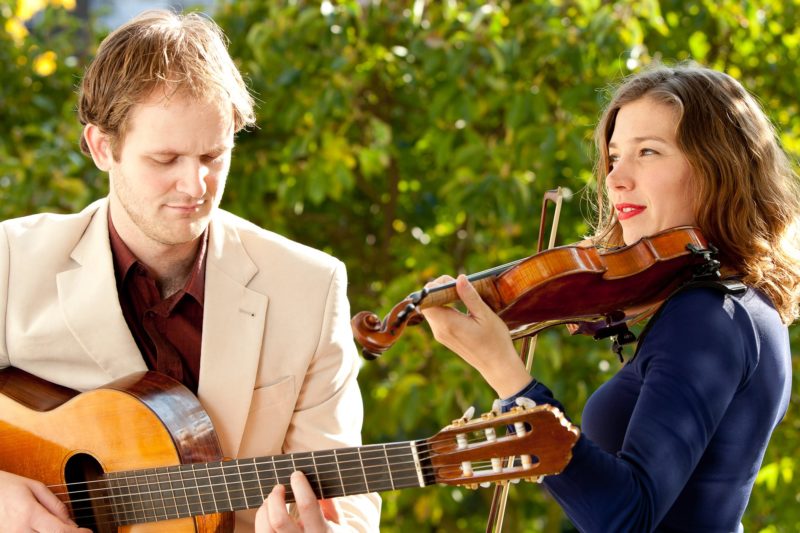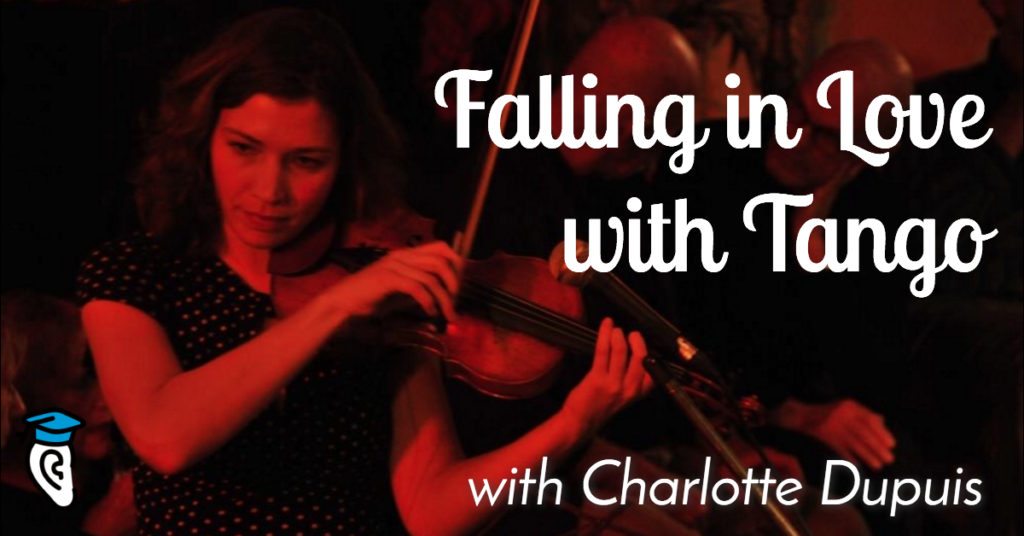Musicians are creating surprising careers by following their hearts. Without ever thinking of being a professional musician, violinist Charlotte Dupuis fell in love with tango music and went on to form one of Europe’s most in-demand original tango bands. We stumbled upon Nuevo Nocturna’s music and sought Charlotte out to learn more about her, the band and about tango music itself:
 As a child, I learned to play the violin; and as a teenager, I joined classical youth orchestras – but also pop and folk bands. I liked to play classical music but never felt that genre was my destiny and I never thought of being a professional musician in the future.
As a child, I learned to play the violin; and as a teenager, I joined classical youth orchestras – but also pop and folk bands. I liked to play classical music but never felt that genre was my destiny and I never thought of being a professional musician in the future.
After high school, I studied architecture, but soon I knew I was going the wrong direction. Music was calling me and I changed career. I became a general music teacher and still love to sing and work with children.
When I was 22 years old, I visited Cuartito Azul, a milonga (which is a place where tango is danced) in Rotterdam (The Netherlands). In this milonga, there is live music – every week – and I fell totally in love with it. The tango, with its warm violin sound, the melancholic bandoneon, the groovy bass, piano and guitar, and the atmosphere of people dancing to live music was something I had never heard or saw before.
I learned that my first tango show at Cuartito Azul was played by the students of the Rotterdam Conservatory – “Codarts”. I picked up my violin again, and soon I passed the Codarts entrance exam. And so began four incredible years as a tango violin student, playing in many big tango events in the Netherlands, Germany, Belgium, and Argentina.
Before Nuevo Nocturna began, I played in a duo with my friend Bruna Perraro (flute, guitar and voice). We both lived in Rotterdam and played almost every week in various concerts and celebrations. We also traveled as street musicians throughout Europe. On one of our trips, Bruna found her love in Palermo. She stayed in Sicily and I returned to Rotterdam with concerts already booked, but without a duo.
Then I heard Mirek Walton play guitar at Cuartito Azul. I immediately loved his sound and asked if he wanted to play the concerts with me. This is how Duo Nocturna started in 2007.
Mirek and I had a very strong musical connection from the start. We liked to play and arrange old tangos – but also to compose. So our repertoire has always included our own compositions. We were lucky, because without really organizing anything, we were always asked to play at various events. We just had a website, business cards, and a CD, but never worked with an agent. After one year we felt we lacked the deep sound of the double bass, especially to play at milongas. We found a tango bass player Alexander Vocking and became Trio Nocturna.
As a trio we won two competitions for danceable music in 2010: the “El choclo” competition for tango compositions and the “Doble ocho” for tango arrangements.
In 2013 we started to play occasionally as a quartet because we met Lysandre Donoso and wanted to add his bandoneon sound to our group. We changed our name again, and now we are Nuevo Nocturna. This name still suits us: we arranged the same repertoire for each band size because nowadays we can be booked as a duo, trio or quartet. That gives us more flexibility in booking events.

There are quite a few important milongas in the Netherlands, with many dancers. Some dancers really have the tango fire – they can dance on and on, maybe every day. I think tango is so alive here because the Netherlands lack their own folklore. In the Netherlands, people from many different countries live together. Tango itself is influenced by many cultures, and people from all over the world can relate to it. Plus, the melancholic sound of tango is the “blues of South America” – a medicine for South American immigrants who miss their roots, or their love.
All the band members of Nuevo Nocturna studied at Codarts. This is a unique conservatory, because it has several world music departments, with top world teachers. In addition to the tango department, but also departments of flamenco, latin, Turkish and Indian music.
At Codarts it’s possible to study Argentinian tango on bachelor’s and master’s level. Leo Vervelde and Carel Kraayenhof, two pioneers of Argentine tango music in Holland, founded the tango department in Rotterdam. They asked one of the most famous tango pianists, Osvaldo Pugliese, to be the artistic director of the course, which he was for many years until he was followed by Gustavo Beytelmann.
Nuevo Nocturna only plays our own arrangements and compositions. Somehow we feel the need to give our own flavor to existing repertoire. That’s why our music has its own sound, yet we play themes from different composers and eras.
Besides composing and arranging we also like to improvise. So we make a space for improvised solos in many of our compositions and arrangements. Mirek Walton is a very advanced improviser. He improvises more that the rest of us. He continues to surprise us with what he comes up with during concerts.
Although I’m influenced by various music styles, I still feel the music comes more out of my imagination and my heart than out of the idea of certain musical genre. Usually, Mirek or I first compose a melody with a chord scheme. This draft chart looks like a jazz standard. Then we meet and play the piece several times. In this first practice, some notes of the melody, or chords, can be changed. If we like the melody and chords, we will use this “standard” as the skeleton of a new composition.
Mirek and I have a strong feeling about songs being good or not. If the melody and chords aren’t interesting or catchy enough, we won’t go on with the piece.
The next step is to play the theme in different ways: different grooves, staccato, legato… We also improvise over the theme to get more ideas. It’s like we are arranging as we play. After a while, we start to hear the composition take shape. The form of the piece also becomes clear.
The one who composed the theme then writes down the whole arrangement of the song at home. When this is done, we come together with the whole ensemble and rehearse the piece as it’s written down. Notes might still be changed over and over again. Usually, we rehearse with the computer next to us and make changes in the score on the spot if we get better ideas. There always comes a moment when we all feel that it works. Then a composition is “finished”. Some compositions are done within a week. Others within a year or two.
There are still places where people only want to dance to familiar tunes, so some tango bands cover only old music. But many Dutch Tango dancers are open to new compositions – as long as they are danceable, with a clear measure, and a strong beat. So even though we have our own sound and repertoire, we are still booked at many milongas in the Netherlands.
In 2017 Nuevo Nocturna marks its 10th anniversary! We shall organize a big concert with our new compositions to celebrate.

When we fall in love, even intense study can feel as light as a dream. What is the music that most pulls your heartstrings? Could it be Nuevo Nocturna’s latest album, Medianoche? Next time we speak with Charlotte Dupuis, we’ll learn more about what makes her beloved tango music tick.







